Best 997GT2 intercooler
#241
Porsche are claiming: New charge air coolers with markedly improved efficiency as well as changed rear lateral intakes which enhances air flow for the charge air coolers -
The new charge air coolers feature a new cooler surface with greater block depths and improved charge air flow this improves efficiency by approx 15% and enables a marked improvement in cooling the charge air
GT2RS
The new charge air coolers feature a new cooler surface with greater block depths and improved charge air flow this improves efficiency by approx 15% and enables a marked improvement in cooling the charge air
GT2RS


Also efficiency being improved by 15%
I would assume 15% cooler IATs ?
#242
I would also like to know what the 15% means and how they measured it ? Possibly 15% lower (compared to GT2) maximum IAT at DIN ambient 20DegC ?
#243
These updates can enchance efficiency to what they claim ....
Honestly i am having doubts about there intercooler claim...
#244
#245
You know what would be funny?
Considering that the 2 RS is running GT1 power figures, what if they are using factory Secans???
It would certainly help justify the price!!! Tell you one thing, 7:18 on the 'Ring is nothing to sneer at, so they must have put some trick parts into this car!!!
Considering that the 2 RS is running GT1 power figures, what if they are using factory Secans???
It would certainly help justify the price!!! Tell you one thing, 7:18 on the 'Ring is nothing to sneer at, so they must have put some trick parts into this car!!!
Porsche are claiming: New charge air coolers with markedly improved efficiency as well as changed rear lateral intakes which enhances air flow for the charge air coolers -
The new charge air coolers feature a new cooler surface with greater block depths and improved charge air flow this improves efficiency by approx 15% and enables a marked improvement in cooling the charge air
GT2RS
The new charge air coolers feature a new cooler surface with greater block depths and improved charge air flow this improves efficiency by approx 15% and enables a marked improvement in cooling the charge air
GT2RS

#248
Glad you guys got sorted 
Just noticed the pressure tesing level on the label above, checked my delivery note and it was the same - 20PSI........ I guess we forgot to tell them that our tuned cars run at 23.5PSI
Am doing some high speed testing/fun next weekend and it should be a bit warmer so will get some real AIT numbers for higher ambients....

Just noticed the pressure tesing level on the label above, checked my delivery note and it was the same - 20PSI........ I guess we forgot to tell them that our tuned cars run at 23.5PSI

Am doing some high speed testing/fun next weekend and it should be a bit warmer so will get some real AIT numbers for higher ambients....
#250
Excuse the multiple posting of this:
How Porsche tuning has grown in the last 20 years is an amazing thing, I have watched it from the early days of Motronic when only a handful of people could even access the code to today when people casually talk about a “flash” as if it is something as simple as an air filter.
Those who may have read my ramblings over the years will know that I am very biased towards the tuning done by race engine builders RS Tuning who have a sophisticated, expensive engine dyno set up and many years of ongoing experience of working with that tool to produce the best performing Porsche race engines in the world. Their road engine packages benefit directly from this experience but they are hideously expensive and are only available if you buy the complete “kit” which goes against the “modular” form of tuning which has grown in this industry where for obvious reasons (which are both financial and for the fun factor) people like to bolt bits on and get a “re-flash” to suit.
We did some data logging at the airstrip a few weeks ago with some generous owners allowing me to plug the Durametrics into their cars to see what was actually happening and what exactly the “flash” was doing to their motors……
The results were quite interesting.
The ambient temperature of the day was about 17 degC
Reading the data in the pics below, unfortunately I haven’t lined up all the columns to read in the same order but you can read them if you look:
We have:
Time, this is the first column always and shows the elapsed time of when the reading is taking place, usually there is an updated reading every 10th of a second or thereabouts.
Engine speed is in RPM, sometimes you may notice that a spurious reading creeps in there – that should be considered a “spike” and not actual.
Mass air flow – this is the amount of air the engine is ingesting in kg/hr, basically the more air, the more power all else being good
IAT is intake air temperature, this is the temperature of the boosted air in the inlet tract, these cars (two 997tts and a 997GT2) work well to 55 degC which is said to be the point where timing starts to be retarded. The GT2 IAT is always higher since the GT2 runs much higher boost (1.6bar) in the inlet which is reduced by the action of the expansion intake manifold so the actual air entering the combustion chambers is not boosted so high and is cooler.
Ignition angle – this is the degree of advance which the engine is running at, basically higher advance number the better and a steady number shows a more balanced engine tune.
Vehicle speed is in KPH so for mph divide by 1.6….. so 200kph is 124mph
The lambda banks 1 & 2 are the readings from the lambda sensors and indicate the air fuel ratios. If you multiply the lambda readings by 14.7 it gives the AFR ie a 0.70 lambda is 10.29:1 AFR.
So to the data:
First up is a 997tt with sports exhaust and 200 cell cats and a “flash” from a BIG and well known German internet tuning house.
This car was fast up to 100mph setting IIRC a 3.4s 0-60mph on the way, the problem for this car was that the aggressive boost led very quickly to high IATs at 68DegC, at the gearchange 5th to 6th there is a good amount of timing advance ~14 degrees but varying quite a bit showing the ECU is working hard to keep the numbers good and AFR around 11:1 which is all good. It has a Mass air flow of 1486kg/hr peak at 6860rpm which represents the air it is using at peak power.
After the gear change the revs drop to 5521 and things start to turn nasty, the high IAT forces the ECU to take some action, the ignition advance is held way back and the mixture is richened to 10:1 to protect the motor from knock onset….. EGTs are well controlled.
This car slowed considerably over the 250kph mark in its physical acceleration and the data graphically shows us why.
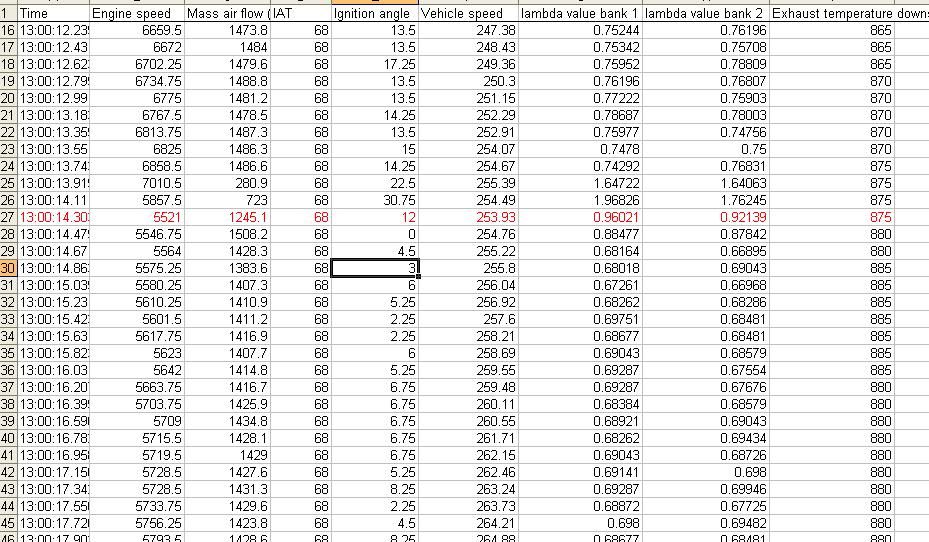
Next up was a 997tt Cab with just a flash from a well know UK “flasher” who has sold a lot of his product in the UK market.
This car appeared very fast chirping its tyres as it changed 1st to second and with the owner reporting wheelspin changing 3rd to 4th gear !!! The acceleration data again showed it started to slow dramatically over 100mph.
Take a look at the data – it is not at the same speed points as the previous run because the owner was changing gear way before the red line.
So we see he changes gear 4th to 5th at 6093rpm IAT is high at 63DegC but the ECU has already been richening the mixture to cool it down with AFRs at 10:1 at the top of 4th gear.
Now checkout the chaos as 5th gear is engaged, possibly because of too high boost, the timing advance goes to pot and is all over the place even retarding the ignition for a couple of readings and the AFRs get as rich as 9.8:1 to cool things down – it appears the ECU does its job and the IAT starts falling – all this activity results in much slower acceleration.
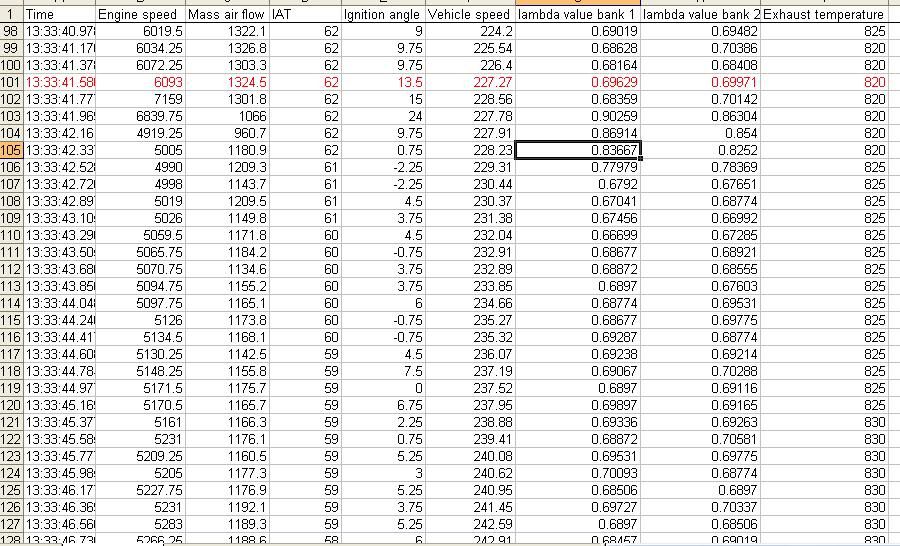
OK so the last two were $2000 “flashes” from “tuners”. My “flash” was a program written by RS Tuning over 2 days on the engine dyno (most of which was doing part load programming so not relevant to these full load runs) specifically for the bolt on turbos, air pipes and 100 cell cats and expensive intercoolers which my GT2 engine has.
Mine is a 4th to 5th gear change. At 6902rpm you can see the Mass air my engine is ingesting is 1775kg/hr – what this data also shows is the “overboost” which RS program into their software. If you look at the data when 5th gear is engaged the Mass air for the first reading is still 1746kg/hr and then descends over the next few readings, this is the program allowing extra boost and extra torque as the next gear is engaged, this also happens if you stomp on the gas pedal in the mid range and gives extra performance in this area – non of the other flashes did this……
Next up, the IATs at 51 degC, lower than the others but remember the GT2 runs 1.6 bar in the inlet manifold so the IATs are always higher. The timing advance speaks for itself both in high degree of advance and in consistency. The AFRs are immaculately controlled with little variation at around 12.2:1 on this engine the IATs go lower as 300kph is breached and all the other numbers stay similarly constant…
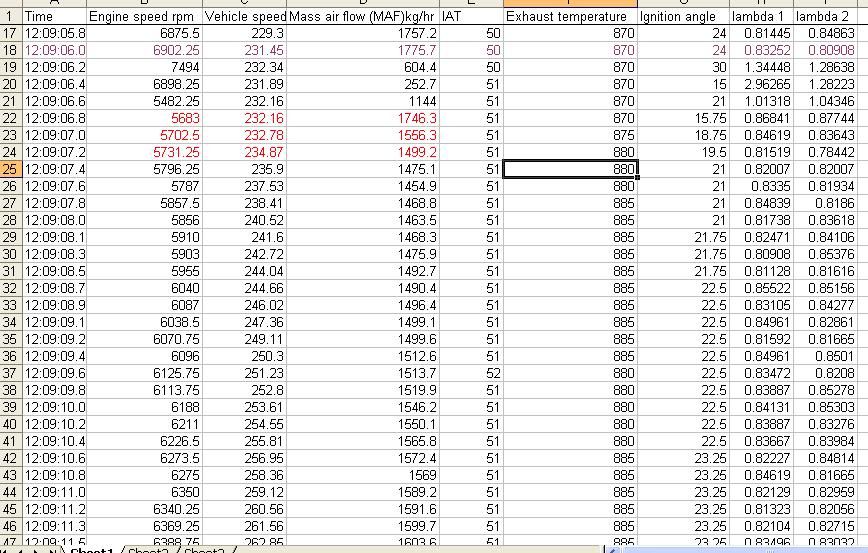
I hope people find this analysis useful and please feel free to correct me on anything I may have said which is incorrect.
The second car really drove it home to me that some people will think they have really fast “tyre shredding” packages – this car was chirping its tyres as I said, but it is all just smoke screen programming to give the illusion of a fast accelerating car.
Just because the numbers are very “pretty” to my eyes below is the data trail of my GT2 up to 190mph, see the dropping IAT, the 22.5 degrees of timing advance and the steady 12.2:1 AFRs – it is poetry – right up until the rods break !
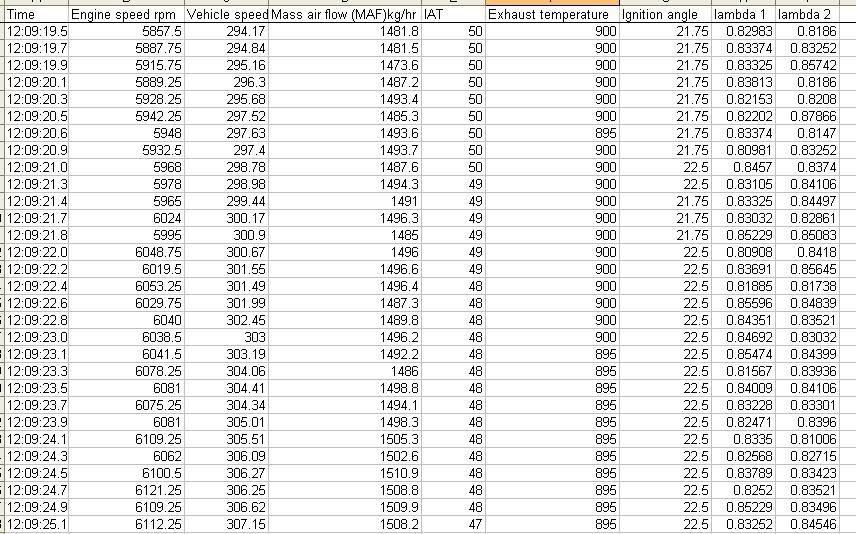
Not sure what this all really means to us enthusiasts ? Certainly modern electronics are awesome and can cope with whatever is thrown at them as long as the safety bits are left in, but to me it makes me even more cynical about "flashes" .....
How Porsche tuning has grown in the last 20 years is an amazing thing, I have watched it from the early days of Motronic when only a handful of people could even access the code to today when people casually talk about a “flash” as if it is something as simple as an air filter.
Those who may have read my ramblings over the years will know that I am very biased towards the tuning done by race engine builders RS Tuning who have a sophisticated, expensive engine dyno set up and many years of ongoing experience of working with that tool to produce the best performing Porsche race engines in the world. Their road engine packages benefit directly from this experience but they are hideously expensive and are only available if you buy the complete “kit” which goes against the “modular” form of tuning which has grown in this industry where for obvious reasons (which are both financial and for the fun factor) people like to bolt bits on and get a “re-flash” to suit.
We did some data logging at the airstrip a few weeks ago with some generous owners allowing me to plug the Durametrics into their cars to see what was actually happening and what exactly the “flash” was doing to their motors……
The results were quite interesting.
The ambient temperature of the day was about 17 degC
Reading the data in the pics below, unfortunately I haven’t lined up all the columns to read in the same order but you can read them if you look:
We have:
Time, this is the first column always and shows the elapsed time of when the reading is taking place, usually there is an updated reading every 10th of a second or thereabouts.
Engine speed is in RPM, sometimes you may notice that a spurious reading creeps in there – that should be considered a “spike” and not actual.
Mass air flow – this is the amount of air the engine is ingesting in kg/hr, basically the more air, the more power all else being good
IAT is intake air temperature, this is the temperature of the boosted air in the inlet tract, these cars (two 997tts and a 997GT2) work well to 55 degC which is said to be the point where timing starts to be retarded. The GT2 IAT is always higher since the GT2 runs much higher boost (1.6bar) in the inlet which is reduced by the action of the expansion intake manifold so the actual air entering the combustion chambers is not boosted so high and is cooler.
Ignition angle – this is the degree of advance which the engine is running at, basically higher advance number the better and a steady number shows a more balanced engine tune.
Vehicle speed is in KPH so for mph divide by 1.6….. so 200kph is 124mph
The lambda banks 1 & 2 are the readings from the lambda sensors and indicate the air fuel ratios. If you multiply the lambda readings by 14.7 it gives the AFR ie a 0.70 lambda is 10.29:1 AFR.
So to the data:
First up is a 997tt with sports exhaust and 200 cell cats and a “flash” from a BIG and well known German internet tuning house.
This car was fast up to 100mph setting IIRC a 3.4s 0-60mph on the way, the problem for this car was that the aggressive boost led very quickly to high IATs at 68DegC, at the gearchange 5th to 6th there is a good amount of timing advance ~14 degrees but varying quite a bit showing the ECU is working hard to keep the numbers good and AFR around 11:1 which is all good. It has a Mass air flow of 1486kg/hr peak at 6860rpm which represents the air it is using at peak power.
After the gear change the revs drop to 5521 and things start to turn nasty, the high IAT forces the ECU to take some action, the ignition advance is held way back and the mixture is richened to 10:1 to protect the motor from knock onset….. EGTs are well controlled.
This car slowed considerably over the 250kph mark in its physical acceleration and the data graphically shows us why.

Next up was a 997tt Cab with just a flash from a well know UK “flasher” who has sold a lot of his product in the UK market.
This car appeared very fast chirping its tyres as it changed 1st to second and with the owner reporting wheelspin changing 3rd to 4th gear !!! The acceleration data again showed it started to slow dramatically over 100mph.
Take a look at the data – it is not at the same speed points as the previous run because the owner was changing gear way before the red line.
So we see he changes gear 4th to 5th at 6093rpm IAT is high at 63DegC but the ECU has already been richening the mixture to cool it down with AFRs at 10:1 at the top of 4th gear.
Now checkout the chaos as 5th gear is engaged, possibly because of too high boost, the timing advance goes to pot and is all over the place even retarding the ignition for a couple of readings and the AFRs get as rich as 9.8:1 to cool things down – it appears the ECU does its job and the IAT starts falling – all this activity results in much slower acceleration.

OK so the last two were $2000 “flashes” from “tuners”. My “flash” was a program written by RS Tuning over 2 days on the engine dyno (most of which was doing part load programming so not relevant to these full load runs) specifically for the bolt on turbos, air pipes and 100 cell cats and expensive intercoolers which my GT2 engine has.
Mine is a 4th to 5th gear change. At 6902rpm you can see the Mass air my engine is ingesting is 1775kg/hr – what this data also shows is the “overboost” which RS program into their software. If you look at the data when 5th gear is engaged the Mass air for the first reading is still 1746kg/hr and then descends over the next few readings, this is the program allowing extra boost and extra torque as the next gear is engaged, this also happens if you stomp on the gas pedal in the mid range and gives extra performance in this area – non of the other flashes did this……
Next up, the IATs at 51 degC, lower than the others but remember the GT2 runs 1.6 bar in the inlet manifold so the IATs are always higher. The timing advance speaks for itself both in high degree of advance and in consistency. The AFRs are immaculately controlled with little variation at around 12.2:1 on this engine the IATs go lower as 300kph is breached and all the other numbers stay similarly constant…

I hope people find this analysis useful and please feel free to correct me on anything I may have said which is incorrect.
The second car really drove it home to me that some people will think they have really fast “tyre shredding” packages – this car was chirping its tyres as I said, but it is all just smoke screen programming to give the illusion of a fast accelerating car.
Just because the numbers are very “pretty” to my eyes below is the data trail of my GT2 up to 190mph, see the dropping IAT, the 22.5 degrees of timing advance and the steady 12.2:1 AFRs – it is poetry – right up until the rods break !

Not sure what this all really means to us enthusiasts ? Certainly modern electronics are awesome and can cope with whatever is thrown at them as long as the safety bits are left in, but to me it makes me even more cynical about "flashes" .....
#251
nice job Toby. It would be interesting to know exactly what kind of exhaust setup is on each car. It would seem to me the cab has the most conservative tune at the expense of power. Your EGT's are the highest yet with the lowest IAT's - certainly the most power extraction possible is being achieved
#252
Gene, would you not think the timing retard and richening mixture on the cab indicates too aggressive a tune, maybe too much boost rather than a conservative tune ? although his EGTs are well controlled...
Exhaust wise, the first car had FVD export with 200 cell, I think the second one was stock and mine is stock with 100cell.
Here is the cab (997tt flash only) running up to 170mph, timing recovers but the readings seem to vary a lot in comparison to mine - does this indicate and "unbalanced" tune ?
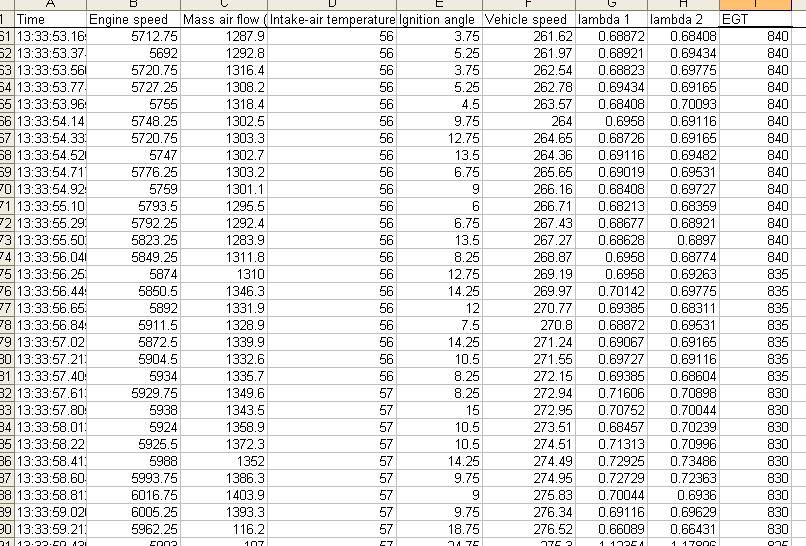
Exhaust wise, the first car had FVD export with 200 cell, I think the second one was stock and mine is stock with 100cell.
Here is the cab (997tt flash only) running up to 170mph, timing recovers but the readings seem to vary a lot in comparison to mine - does this indicate and "unbalanced" tune ?

#253
Gene, would you not think the timing retard and richening mixture on the cab indicates too aggressive a tune, maybe too much boost rather than a conservative tune ? although his EGTs are well controlled...
Exhaust wise, the first car had FVD export with 200 cell, I think the second one was stock and mine is stock with 100cell.
Exhaust wise, the first car had FVD export with 200 cell, I think the second one was stock and mine is stock with 100cell.
#254
I see what you mean....
Here is a clip from the data earlier in the acceleration run, it reaches 1457kg/hr at max revs getting to 100 mph but the IAT is shooting up so fast that I am guess the erratic timing retardation and mixture richening is a result of a crappy "flash" program which also reigns back the boost/MAF ?
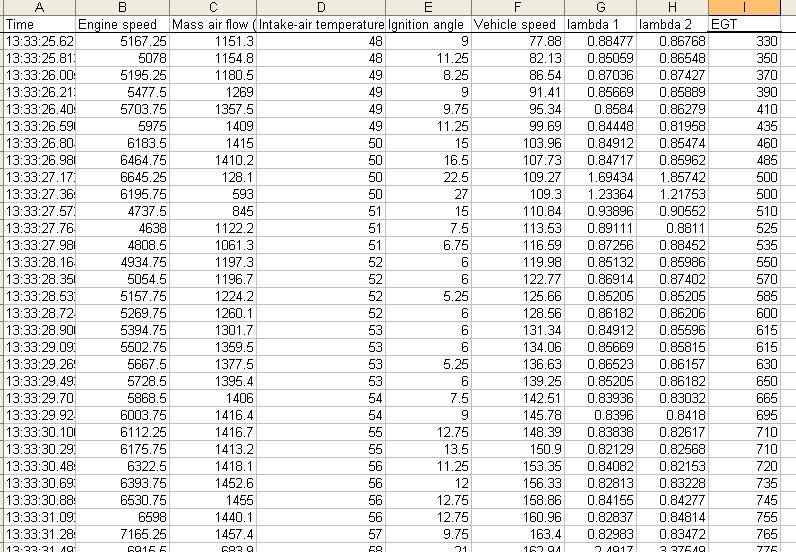
Here is a clip from the data earlier in the acceleration run, it reaches 1457kg/hr at max revs getting to 100 mph but the IAT is shooting up so fast that I am guess the erratic timing retardation and mixture richening is a result of a crappy "flash" program which also reigns back the boost/MAF ?





